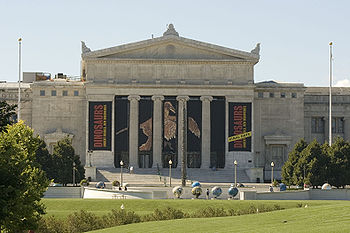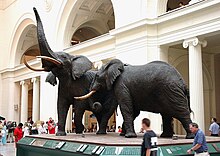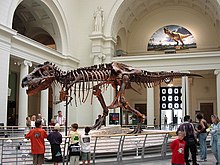Field Museum of Natural History
 The Field Museum of Natural History as seen from the north |
|
| Data | |
|---|---|
| place | Chicago , USA |
| Art | |
| architect | Daniel H. Burnham & Co. or Burnham Graham & Co. |
| opening | 1893 |
| Number of visitors (annually) | approx. 2,000,000 annually |
| Website | |
The Field Museum of Natural History ( FMNH for short ) is a natural history museum in Chicago and one of the best-visited cultural institutions in the United States. With approximately 85,000 square meters on five levels, more than 500 permanent and just as many volunteers, and an annual budget of more than 50 million dollars, it is one of the largest museums in the world. A complete tour in one day is considered difficult.
The Field Museum is in close proximity to the John G. Shedd Aquarium and the Adler Planetarium . The three institutions make up the Museum Campus Chicago .
history

The museum was founded in 1893 as the Columbian Museum of Chicago . After initially even art was one of his areas of collection, with the renaming in 1905 the focus was on natural sciences and ethnology. The namesake Marshall Field ensured that the foundation's assets are still significant today . In 1921, today's house on the shores of Lake Michigan could be moved into.
Collections and Research
The Field Museum houses more than 22 million preserved organisms and other collection items. In this sector it is one of the largest scientific and anthropological collections in the world. Numerous researchers are in contact through loans or work temporarily in the collections. The following departments are represented: ethnology, geology, botany, zoology, office for environmental and nature protection and office for cultural exchange.
The museum also has a specialist library with more than 250,000 titles. There is a lively exchange with the local universities, especially with the University of Chicago and the University of Illinois at Chicago . In contrast to European museums, it is important that the universities receive their own departments for systematics and taxonomy and do not give up through this cooperation. So-called classical biology, which also deals with whole organisms, continues to be promoted in the USA.
Museum education
The Field is one of the first museums to offer an extensive range of educational opportunities. The Harris education program started as early as 1912, which particularly endeavors to train students and teachers. The independent department for education began its work in 1922.
Since June 2013, the YouTube channel The Brain Scoop has been located at the Field Museum. As Chief Curiosity Correspondent, presenter Emily Graslie reports on the museum's collections and staff in regular video reports.
Exhibitions
Around 2 million visitors come every year. All age groups are encountered, even if the proportion of children and young people is the greatest. The animals shown include numerous dermoplastics by Carl Ethan Akeley (1864–1926), one of the most important and innovative taxidermists of the 20th century. The quality of the dioramas is comparable to that in the American Museum of Natural History in New York and the National Museum of Natural History in Washington.
Permanent exhibitions

- biology
- Development of life
- General animal science
- Bird habitats
- Primates
- The Tsavo Lions
- African mammals
- Asiatic mammals
- Man-eater from Mfuwe
- Nature trails
- North American birds
- Plants of the world
- Reptiles and amphibians
- Marine mammals
- Adventure soil
- What is an animal
- World of mammals
- geology
- General geology
- Meteorites and cosmos
- Grainger gallery of minerals and cultural treasures
- Hall of Jade
- McDonald's Fossil Preparation Laboratory
- Moving earth
- paleontology
- Sue
- Ethnology
- Africa
- Past Egypt
- Eskimos and northwestern coastal tribes
- The first Americans
- Asia
- Journey across the Pacific
Others
The plot of the book for the film The Relic of Douglas Preston and Lincoln Child takes place in the American Museum of Natural History , but the film itself was shot in the Field Museum of Natural History . The murals in the permanent exhibition The Story of Food Plants come from the German decorative and art painter Julius Mössel .
Individual evidence
- ^ Port of Aden from the Sea . December 1894. Retrieved July 7, 2013.
- ^ The Mural Gallery. In: The Story of Food Plants. The Field Museum, archived from the original on March 18, 2009 ; accessed on September 5, 2012 .
Web links
Coordinates: 41 ° 51 '58.9 " N , 87 ° 37' 0.5" W.



